Protective Effects of Velvet Antler Polypeptides on Cyclophosphamide-Induced Myelosuppression in Mouse and Bone Marrow Mesenchymal Stem Cells
Abstract
1. Introduction
2. Materials and Methods
2.1. Reagents and Materials
2.2. Experimental Animals
2.3. Preparation and Amino Acid Composition Analysis of VAPs
2.4. Amino Acid Analysis
2.5. Cell Experiments
2.5.1. Isolation and Culture of BMSCs
2.5.2. Flow Cytometry
2.5.3. CCK-8 Assay for Proliferation Activity of BMSCs
2.5.4. Cell Grouping and Treatment
2.5.5. ELISA Detection of VEGF, TPO, and VCAM-1 Content in Bone Marrow Mesenchymal Stem Cells
2.5.6. Determination of Intracellular ROS Levels
2.5.7. Hoechst33342/PI Staining Method for Apoptosis Detection
2.6. Animal Experiments
2.6.1. Animal Grouping and Treatment
2.6.2. Peripheral Blood Analysis
2.6.3. Organ Index
2.6.4. Hematoxylin and Eosin Staining (HE)
2.6.5. Detection of VEGF, TPO, and VCAM-1 Levels in Serum
2.6.6. BMNC Count
2.6.7. Immunohistochemical Analysis
2.7. Western Blot
2.8. Statistical Analysis
3. Results
3.1. Amino Acid Composition of VAPs
3.2. Characterization of BMSCs
3.3. The Effects of VAPs on VEGF, TPO, and VCAM-1 in CTX-Induced BMSCs
3.4. Effects of VAPs on CTX-Induced Apoptosis and ROS Levels in BMSCs
3.5. Regulation of the PI3K/AKT Signaling Pathway Within BMSCs by VAPs
3.6. The PI3K Inhibitor LY294002 Verified the Effect of VAPs on the Proteins of the PI3K/AKT Pathway in BMSCs
3.7. General Condition of Mice
3.8. Peripheral Blood Cells
3.9. Bone Marrow Nucleated Cell Count and Organ Index Analysis
3.10. VAPs’ Effects on the Histopathological Morphology of the Femur, Spleen, and Liver Tissues in Myelosuppression Mice
3.11. Effects of VAPs on Hematopoietic-Related Cytokines in Myelosuppression Mice
3.12. Protein Expression of CD34, VEGF, and Notch1 in Bone Marrow Tissue
3.13. VAPs’ Effects on the PI3K/AKT Pathway and Notch1 in Myelosuppression Mice
3.14. The PI3K Inhibitor LY294002 Verified the Effect of VAPs on the Proteins of the PI3K/AKT Pathway
3.15. The Notch1 Inhibitor DAPT Validated the Effects of VAPs on Notch1 and PI3K/AKT Pathway Proteins
4. Discussion
5. Conclusions
Author Contributions
Funding
Institutional Review Board Statement
Informed Consent Statement
Data Availability Statement
Conflicts of Interest
References
- Bray, F.; Laversanne, M.; Sung, H.; Ferlay, J.; Siegel, R.L.; Soerjomataram, I.; Jemal, A. Global cancer statistics 2022: GLOBOCAN estimates of incidence and mortality worldwide for 36 cancers in 185 countries. CA A Cancer J. Clin. 2024, 74, 229–263. [Google Scholar] [CrossRef]
- Pal, C.; Kumar, A.; Kumar, S.; Singh, P.P.; Ghodake, G.; Bhattacharyya, S.; Yadav, A.K.; Kumar, U.; Kumar, D. Recent advances in imidazole-hybrid pharmacophores for anti-cancer applications. J. Mol. Struct. 2026, 1351, 144269. [Google Scholar] [CrossRef]
- Long, J.; Lai, H.; Huang, Y.; You, F.; Jiang, Y.; Kuang, Q. Unraveling the pathogenesis of bone marrow hematopoietic injury and the therapeutic potential of natural products. Pharmacol. Res. 2025, 212, 107589. [Google Scholar] [CrossRef]
- Liu, L.; Li, H.; Patterson, A.M.; Plett, P.A.; Sampson, C.H.; Mohammad, K.S.; Capitano, M.L.; Singh, P.; Yao, C.; Orschell, C.M.; et al. Upregulation of SIRT1 Contributes to dmPGE2-dependent Radioprotection of Hematopoietic Stem Cells. Stem Cell Rev. Rep. 2022, 18, 1478–1494. [Google Scholar] [CrossRef]
- Que, L.; He, L.; Yu, C.; Yin, W.; Ma, L.; Cao, B.; Yu, S. Activation of Nrf2-ARE signaling mitigates cyclophosphamide-induced myelosuppression. Toxicol. Lett. 2016, 262, 17–26. [Google Scholar] [CrossRef]
- Farzaneh, A.; Mehrzad, S. Comparison of the effects of pegylated granulocyte-colony stimulating factor and granulocyte-colony stimulating factor on cytopenia induced by dose-dense chemotherapy in breast cancer patients. J. Res. Med. Sci. Off. J. Isfahan Univ. Med. Sci. 2018, 23, 73. [Google Scholar]
- Xia, P.; Liu, D.; Jiao, Y.; Wang, Z.; Chen, X.; Zheng, S.; Fang, J.; Hao, L. Health Effects of Peptides Extracted from Deer Antler. Nutrients 2022, 14, 4183. [Google Scholar] [CrossRef]
- Wang, P.; Sun, T.-F.; Li, G.; Zhang, H.-M.; Liu, F.-J.; Gao, Z.-H.; Cao, S.-N.; Sun, G.-D.; Du, H.-T.; Wang, C.-A.; et al. The Separation of Antler Polypeptide and Its Effects on the Proliferation and Osteogenetic Differentiation of Bone Marrow Mesenchymal Stem Cells. Evid.-Based Complement. Altern. Med. 2020, 2020, 1294151. [Google Scholar] [CrossRef] [PubMed]
- Zhang, L.-Z.; Xin, J.-L.; Zhang, X.-P.; Fu, Q.; Zhang, Y.; Zhou, Q.-L. The anti-osteoporotic effect of velvet antler polypeptides from Cervus elaphus Linnaeus in ovariectomized rats. J. Ethnopharmacol. 2013, 150, 181–186. [Google Scholar] [CrossRef] [PubMed]
- Wu, Q.; Li, Y.; Ye, R.; Wang, H.; Ge, Y. Velvet antler polypeptide (VAP) protects against cerebral ischemic injury through NF-κB signaling pathway in vitro. J. Stroke Cerebrovasc. Dis. 2024, 33, 107666. [Google Scholar] [CrossRef] [PubMed]
- Liu, X.; Yang, Q.; Li, H.; Lan, X.; Kan, M.; Lin, J.; Wang, J.; Zhang, Z.; Ming, S.; Li, Z.; et al. The anti-aging effect of velvet antler polypeptide is dependent on modulation of the gut microbiota and regulation of the PPARα/APOE4 pathway. J. Integr. Neurosci. 2021, 20, 573–583. [Google Scholar] [CrossRef] [PubMed]
- Dong, Y.; Lu, Z.; Gao, T.; Wei, Z.; Ou, Z.; Shi, Z.; Shen, J. A polypeptide derived from pilose antler ameliorates CUMS-induced depression-like behavior by SENP2-PLCβ4 signaling axis. Eur. J. Pharmacol. 2023, 963, 176247. [Google Scholar] [CrossRef] [PubMed]
- Zhang, M.; Li, N.; Qu, X.B.; Luo, S.; Drummen, G.P.C. Total velvet-antler polypeptide extract from Cervus nippon Temminck induces cell proliferation and activation of the PI3K–Akt signalling pathway in human peripheral blood lymphocytes. Anim. Prod. Sci. 2016, 56, 1008–1015. [Google Scholar] [CrossRef]
- Hong, F.; Chen, Y.; Gao, H.; Shi, J.; Lu, W.; Ju, W.; Fu, C.; Qiao, J.; Xu, K.; Zeng, L. NLRP1 in Bone Marrow Microenvironment Controls Hematopoietic Reconstitution After Transplantation. Transplant. Cell. Ther. 2021, 27, 908.e1–908.e11. [Google Scholar] [CrossRef]
- Wang, G.; Meng, Y.; Ouyang, W.; Zhao, C.; Zhao, W. Effect of pilose antler polypeptide on the mechanism of bone homeostasis in osteoporosis. Front. Med. 2023, 10, 1289843. [Google Scholar] [CrossRef]
- Li, F.; Jia, D.; Yao, K. Amino acid composition and functional properties of collagen polypeptide from Yak (Bos grunniens) bone. LWT - Food Sci. Technol. 2008, 42, 945–949. [Google Scholar] [CrossRef]
- Liu, F.; Yuan, Y.; Bai, L.; Yuan, L.; Li, L.; Liu, J.; Chen, Y.; Lu, Y.; Cheng, J.; Zhang, J. LRRc17 controls BMSC senescence via mitophagy and inhibits the therapeutic effect of BMSCs on ovariectomy-induced bone loss. Redox Biol. 2021, 43, 101963. [Google Scholar] [CrossRef]
- Hu, Y.; Xiong, Y.; Zha, K.; Tao, R.; Chen, L.; Xue, H.; Yan, C.; Lin, Z.; Endo, Y.; Cao, F.; et al. Melatonin Promotes BMSCs Osteoblastic Differentiation and Relieves Inflammation by Suppressing the NF-κB Pathways. Stem Cells Int. 2023, 2023, 1–10. [Google Scholar] [CrossRef]
- Li, L.; Tang, P.; Zhou, Z.; Wang, Q.; Xu, T.; Zhao, S.; Huang, Y.; Kong, F.; Liu, W.; Cheng, L.; et al. GIT1 regulates angiogenic factor secretion in bone marrow mesenchymal stem cells via NF-κB/Notch signalling to promote angiogenesis. Cell Prolif. 2019, 52, e12689. [Google Scholar] [CrossRef] [PubMed]
- Ning, M.S.; Ahobila, V.; Jhingran, A.; Stecklein, S.R.; Frumovitz, M.; Schmeler, K.M.; Eifel, P.J.; Klopp, A.H. Outcomes and patterns of relapse after definitive radiation therapy for oligometastatic cervical cancer. Gynecol. Oncol. 2017, 148, 132–138. [Google Scholar] [CrossRef]
- Anthony, B.A.; Link, D.C. Regulation of hematopoietic stem cells by bone marrow stromal cells. Trends Immunol. 2014, 35, 32–37. [Google Scholar] [CrossRef]
- Zhang, Y.; Zhai, W.; Zhao, M.; Li, D.; Chai, X.; Cao, X.; Meng, J.; Chen, J.; Xiao, X.; Li, Q.; et al. Effects of iron overload on the bone marrow microenvironment in mice. PLoS ONE 2015, 10, e0120219. [Google Scholar] [CrossRef]
- Palomero, T.; Sulis, M.L.; Cortina, M.; Real, P.J.; Barnes, K.; Ciofani, M.; Caparros, E.; Buteau, J.; Brown, K.; Perkins, S.L.; et al. Mutational loss of PTEN induces resistance to NOTCH1 inhibition in T-cell leukemia. Nat. Med. 2007, 13, 1203–1210. [Google Scholar] [CrossRef]
- Mendes, R.D.; Canté-Barrett, K.; Pieters, R.; Meijerink, J.P.P. The relevance of PTEN-AKT in relation to NOTCH1-directed treatment strategies in T-cell acute lymphoblastic leukemia. Haematologica 2016, 101, 1010–1017. [Google Scholar] [CrossRef]
- Efimenko, E.; Davé, U.P.; Lebedeva, I.V.; Shen, Y.; Sanchez-Quintero, M.J.; Diolaiti, D.; Kung, A.; Lannutti, B.J.; Chen, J.; Realubit, R.; et al. PI3Kγ/δ and NOTCH1 cross-regulate pathways that define the T-cell acute lymphoblastic leukemia disease signature. Mol. Cancer Ther. 2017, 16, 2069–2082. [Google Scholar] [CrossRef]
- Javarappa, K.K.; Tsallos, D.; Heckman, C.A. A Multiplexed Screening Assay to Evaluate Chemotherapy-Induced Myelosuppression Using Healthy Peripheral Blood and Bone Marrow. SLAS Discov. Adv. Sci. Drug Discov. 2018, 23, 687–696. [Google Scholar] [CrossRef] [PubMed]
- Epstein, R.S.; Basu Roy, U.K.; Aapro, M.; Salimi, T.; Moran, D.; Krenitsky, J.; Leone-Perkins, M.L.; Girman, C.; Schlusser, C.; Crawford, J. Cancer Patients’ Perspectives and Experiences of Chemotherapy-Induced Myelosuppression and Its Impact on Daily Life. Patient Prefer. Adherence 2021, 15, 453–465. [Google Scholar] [CrossRef]
- Zhang, T.; Xiao, D.; Zhou, M.; Lin, Y.; Zhang, T.; Cai, X. Protective effect of osteogenic growth peptide functionalized tetrahedral DNA nanostructure on bone marrow and bone formation ability in chemotherapy-induced myelosuppressive mice. Chin. Chem. Lett. 2024, 36, 110594. [Google Scholar] [CrossRef]
- Wang, D.-H.; Ma, X.-N.; Wang, Y.; Wei, Y.-X.; Hu, P.; Pan, Y. Validated herbal extracts for alleviating chemotherapy-induced myelosuppression: A systematic review and meta-analysis. Phytomedicine 2025, 141, 156659. [Google Scholar] [CrossRef]
- Chen, J.; Lin, Z.; Ding, J. Zusanli (ST36) Acupoint Injection with Dexamethasone for Chemotherapy-Induced Myelosuppression: A Systematic Review and Meta-Analysis. Front. Oncol. 2021, 11, 684129. [Google Scholar] [CrossRef] [PubMed]
- Yenenesh, A.; Nigusse, R.; Gulelat, D.; Ali, M.; Adey, M. Amino acid profile and protein quality in tuber and leaf of Coccnia abyssinica (Lam.) (Cogn.) accessions of Ethiopia. Food Sci. Nutr. 2017, 5, 722–729. [Google Scholar]
- Mohadese, H.B.; Vahid, H.S.; Maryam, M.; KingHwa, L.; Pooria, S.K.; Pouya, S.K.; Rajesh, R. Directional capacity of Human Mesenchymal Stem Cells to support Hematopoietic Stem Cell proliferation in vitro. Gene 2022, 820, 146218. [Google Scholar] [CrossRef]
- Moll, M.N.; Nawaz, Q.; Kunisch, E.; Ahrens, T.; Walker, T.; Renkawitz, T.; Boccaccini, A.R.; Westhauser, F. Mesoporous bioactive glass nanoparticles exhibit intrinsic angiogenic potential in the chorioallantoic membrane assay, without the addition of exogenous cells. Altern. Lab. Anim. ATLA 2025, 53, 2611929251366421. [Google Scholar] [CrossRef]
- Melo, T.C.d.; Ariga, S.K.K.; Lima, T.M.d.; Levy, D.; Bydlowski, S.P.; Soriano, F.G. Impact of sepsis on bone marrow mesenchymal stem cells and its implications for hematopoiesis and immunosuppression. Inflamm. Res. 2025, 74, 115. [Google Scholar] [CrossRef]
- Liu, Y.; Huang, W.; Wang, H.; Lu, W.; Guo, J.; Yu, L.; Wang, L. Influence of SPIO labelling on the function of BMSCs in chemokine receptors expression and chemotaxis. PeerJ 2023, 11, e15388. [Google Scholar] [CrossRef] [PubMed]
- Chen, S.; Wang, J.; Fang, Q.; Gao, R.; Shi, Q.; Zhang, H.; Zhao, J. Upregulated heme oxygenase-1 expression of mouse mesenchymal stem cells resists to chemotherapy-induced bone marrow suppression. Chin. Med. J. 2024, 127, 1310–1316. [Google Scholar] [CrossRef]
- Bhardwaj, J.K.; Bikal, P.; Sachdeva, S.N. Chemotherapeutic drugs induced female reproductive toxicity and treatment strategies. J. Biochem. Mol. Toxicol. 2023, 37, e23371. [Google Scholar] [CrossRef]
- Alesi, L.R.; Nguyen, Q.-N.; Stringer, J.M.; Winship, A.L.; Hutt, K.J. The future of fertility preservation for women treated with chemotherapy. Reprod. Fertil. 2023, 4, e220123. [Google Scholar] [CrossRef]
- Mazur, L.; Czyzewska, A.; Bochenek, M. Flow cytometric detection of apoptotic bone marrow cells with fractional DNA content after application of WR-2721, cyclophosphamide, cisplatin, and exposure of mice to gamma rays. Hum. Exp. Toxicol. 2002, 21, 335–341. [Google Scholar] [CrossRef] [PubMed]
- Patra, K.; Bose, S.; Sarkar, S.; Rakshit, J.; Jana, S.; Mukherjee, A.; Roy, A.; Mandal, D.P.; Bhattacharjee, S. Amelioration of cyclophosphamide induced myelosuppression and oxidative stress by cinnamic acid. Chem.-Biol. Interact. 2012, 195, 231–239. [Google Scholar] [CrossRef]
- Deng, J.; Zhong, Y.-F.; Wu, Y.-P.; Luo, Z.; Sun, Y.-M.; Wang, G.-E.; Kurihara, H.; Li, Y.-F.; He, R.-R. Carnosine attenuates cyclophosphamide-induced bone marrow suppression by reducing oxidative DNA damage. Redox Biol. 2018, 14, 1–6. [Google Scholar] [CrossRef]
- Samakova, A.; Gazova, A.; Sabova, N.; Valaskova, S.; Jurikova, M.; Kyselovic, J. The PI3k/Akt Pathway Is Associated With Angiogenesis, Oxidative Stress and Survival of Mesenchymal Stem Cells in Pathophysiologic Condition in Ischemia. Physiol. Res. 2019, 68, S131–S138. [Google Scholar] [CrossRef]
- Teng, Y.; Fan, Y.; Ma, J.; Lu, W.; Liu, N.; Chen, Y.; Pan, W.; Tao, X. The PI3K/Akt Pathway: Emerging Roles in Skin Homeostasis and a Group of Non-Malignant Skin Disorders. Cells 2021, 10, 1219. [Google Scholar] [CrossRef] [PubMed]
- Yu, S.; Li, Y. Dexamethasone inhibits podocyte apoptosis by stabilizing the PI3K/Akt signal pathway. BioMed Res. Int. 2013, 2013, 326986. [Google Scholar]
- Zhou, P.-H.; Hu, W.; Zhang, X.-B.; Wang, W.; Zhang, L.-J. Protective Effect of Adrenomedullin on Rat Leydig Cells from Lipopolysaccharide-Induced Inflammation and Apoptosis via the PI3K/Akt Signaling Pathway ADM on Rat Leydig Cells from Inflammation and Apoptosis. Mediat. Inflamm. 2016, 2016, 7201549. [Google Scholar] [CrossRef]
- Chen, B.-C.; Hung, M.-Y.; Wang, H.-F.; Yeh, L.-J.; Pandey, S.; Chen, R.-J.; Chang, R.-L.; Viswanadha, V.P.; Lin, K.-H.; Huang, C.-Y. GABA tea attenuates cardiac apoptosis in spontaneously hypertensive rats (SHR) by enhancing PI3K/Akt-mediated survival pathway and suppressing Bax/Bak dependent apoptotic pathway. Environ. Toxicol. 2018, 33, 789–797. [Google Scholar] [CrossRef]
- Liu, J.; Zhang, X.; Yue, S.; Fu, J.; Chen, J.; Huang, R.; Shang, P.; Zhong, K.; Guo, S.; Jiao, X.; et al. The anti-apoptotic and anti-autophagic effects of EPO through PI3K/Akt/mTOR signaling pathway in MAC-T cells. Res. Vet. Sci. 2022, 149, 1–10. [Google Scholar] [CrossRef] [PubMed]
- Hales, E.C.; Taub, J.W.; Matherly, L.H. New insights into Notch1 regulation of the PI3K-AKT-mTOR1 signaling axis: Targeted therapy of γ-secretase inhibitor resistant T-cell acute lymphoblastic leukemia. Cell. Signal. 2013, 26, 149–161. [Google Scholar] [CrossRef]
- Calzavara, E.; Chiaramonte, R.; Cesana, D.; Basile, A.; Sherbet, G.V.; Comi, P. Reciprocal regulation of Notch and PI3K/Akt signalling in T-ALL cells in vitro. J. Cell. Biochem. 2008, 103, 1405–1412. [Google Scholar] [CrossRef]
- Cai, Z.; Zhao, B.; Deng, Y.; Shangguan, S.; Zhou, F.; Zhou, W.; Li, X.; Li, Y.; Chen, G. Notch signaling in cerebrovascular diseases (Review). Mol. Med. Rep. 2016, 14, 2883–2898. [Google Scholar] [CrossRef]
- Zhang, R.; Engler, A.; Taylor, V. Notch: An interactive player in neurogenesis and disease. Cell Tissue Res. 2017, 371, 73–89. [Google Scholar] [CrossRef] [PubMed]
- Cheng, Y.-Y.; Ding, Y.-X.; Bian, G.-L.; Chen, L.-W.; Yao, X.-Y.; Lin, Y.-B.; Wang, Z.; Chen, B.-Y. Reactive Astrocytes Display Pro-inflammatory Adaptability with Modulation of Notch-PI3K-AKT Signaling Pathway Under Inflammatory Stimulation. Neuroscience 2020, 440, 130–145. [Google Scholar] [CrossRef] [PubMed]
- Liu, C.; Ge, H.; Shen, C.; Hu, D.; Zhao, X.; Qin, R.; Wang, Y. NOTCH3 promotes malignant progression of bladder cancer by directly regulating SPP1 and activating PI3K/AKT pathway. Cell Death Dis. 2024, 15, 840. [Google Scholar] [CrossRef] [PubMed]
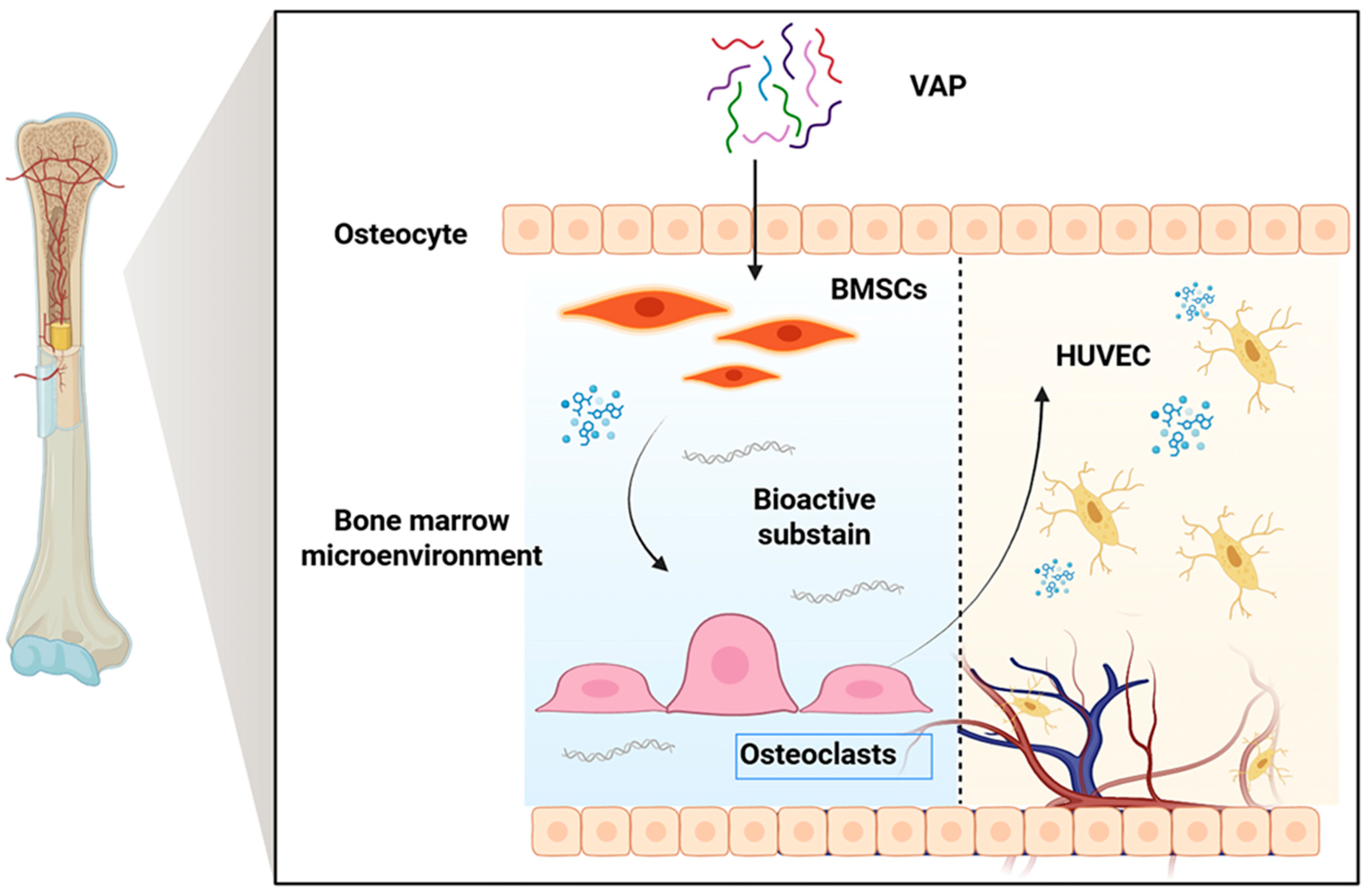
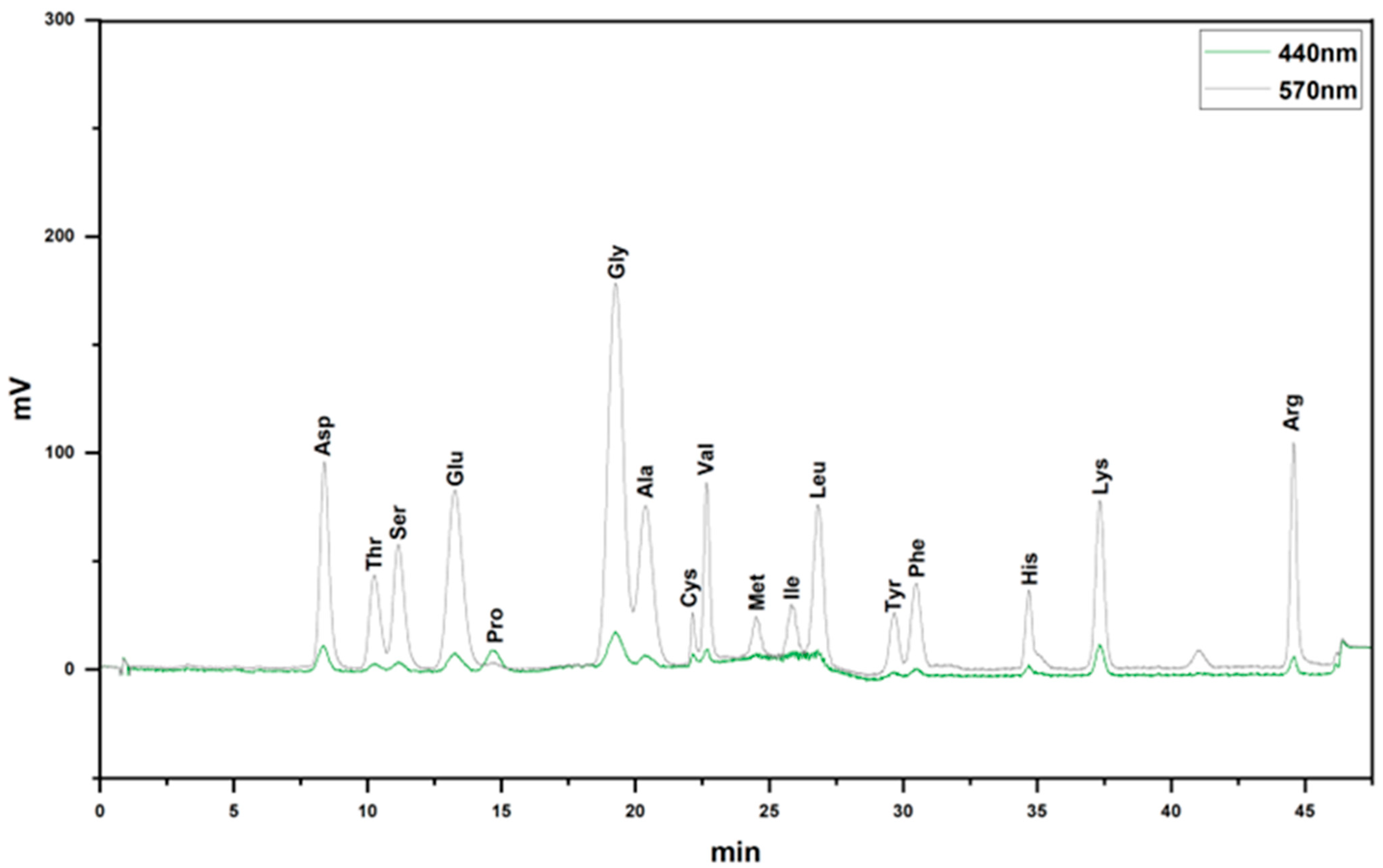






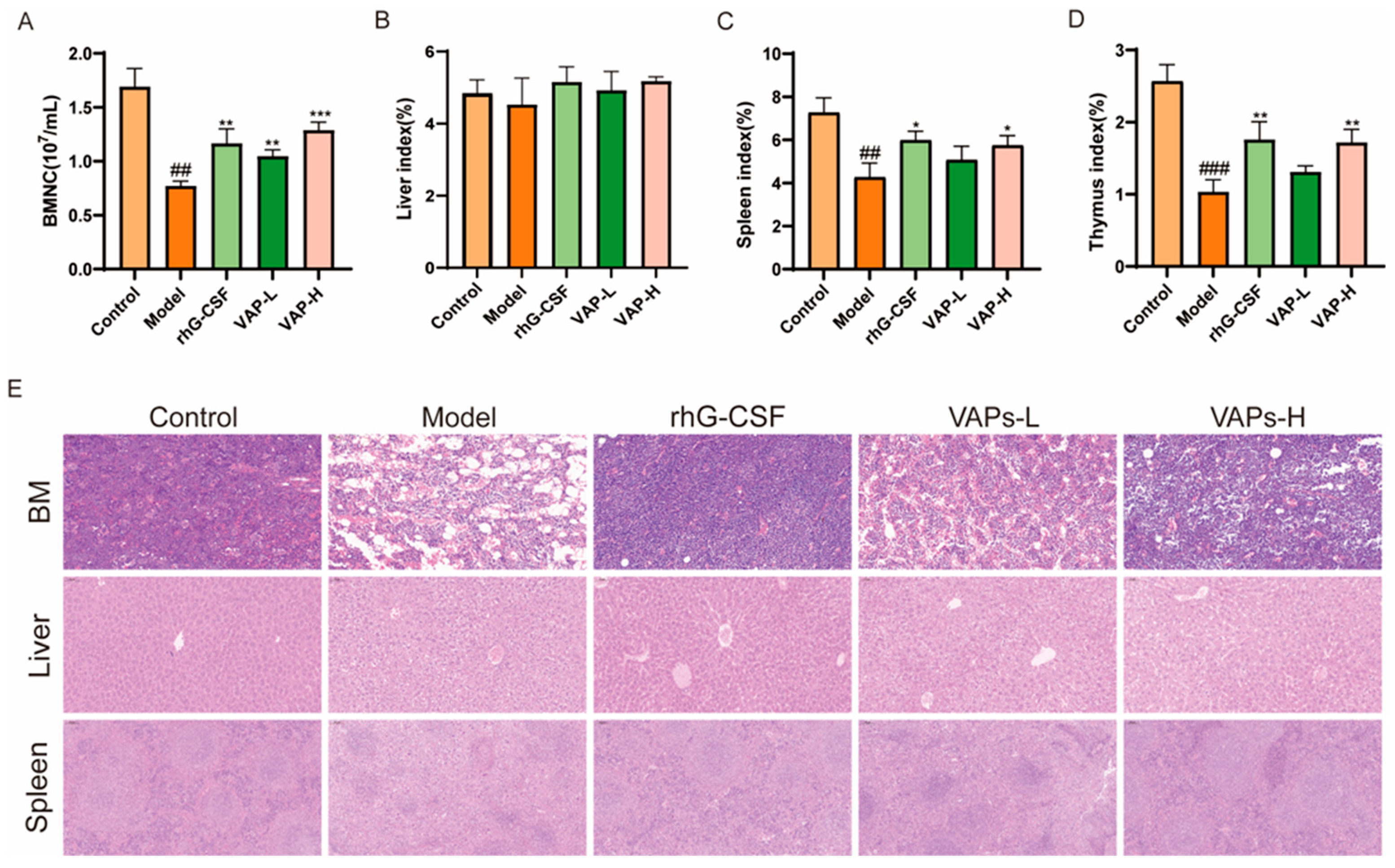
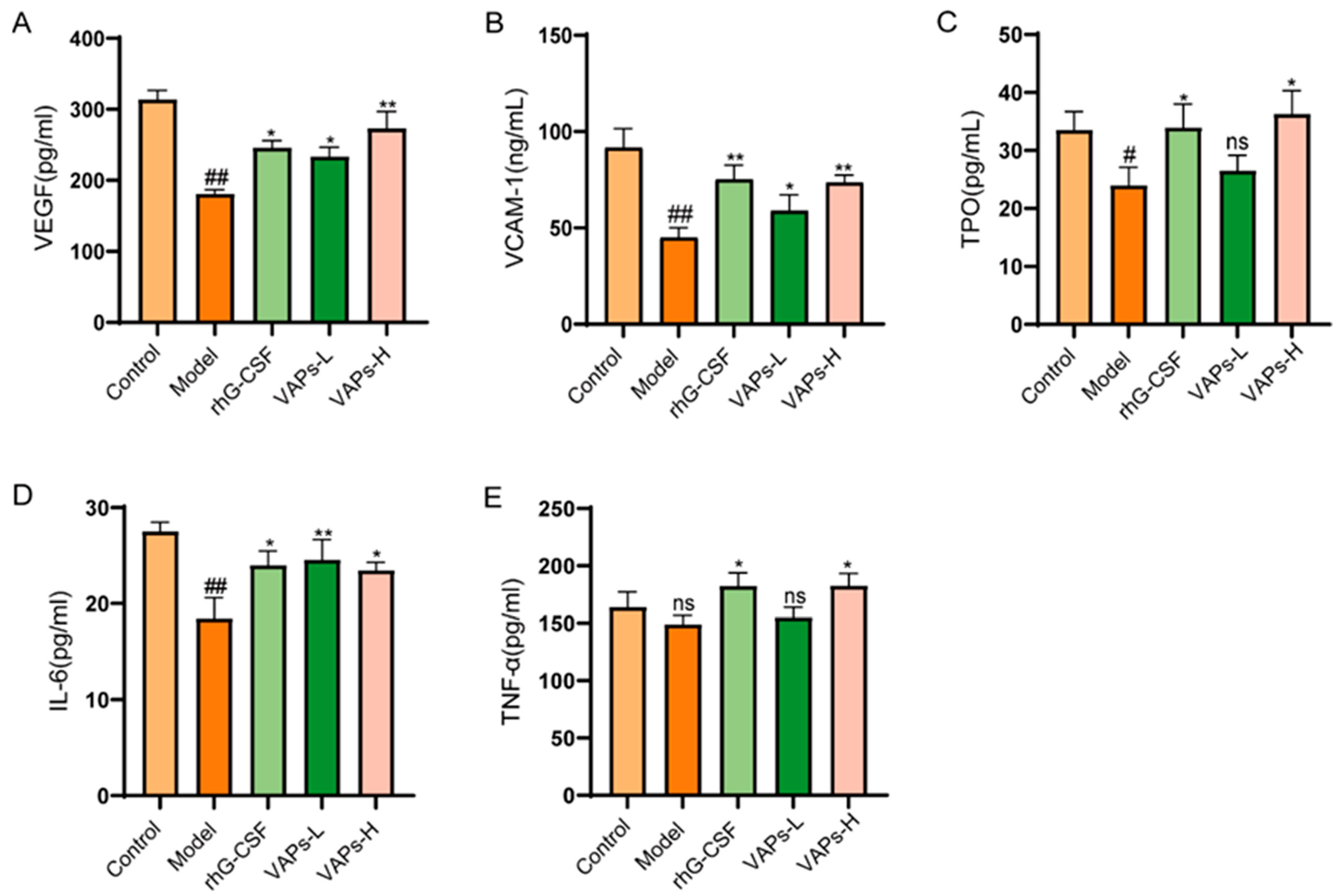
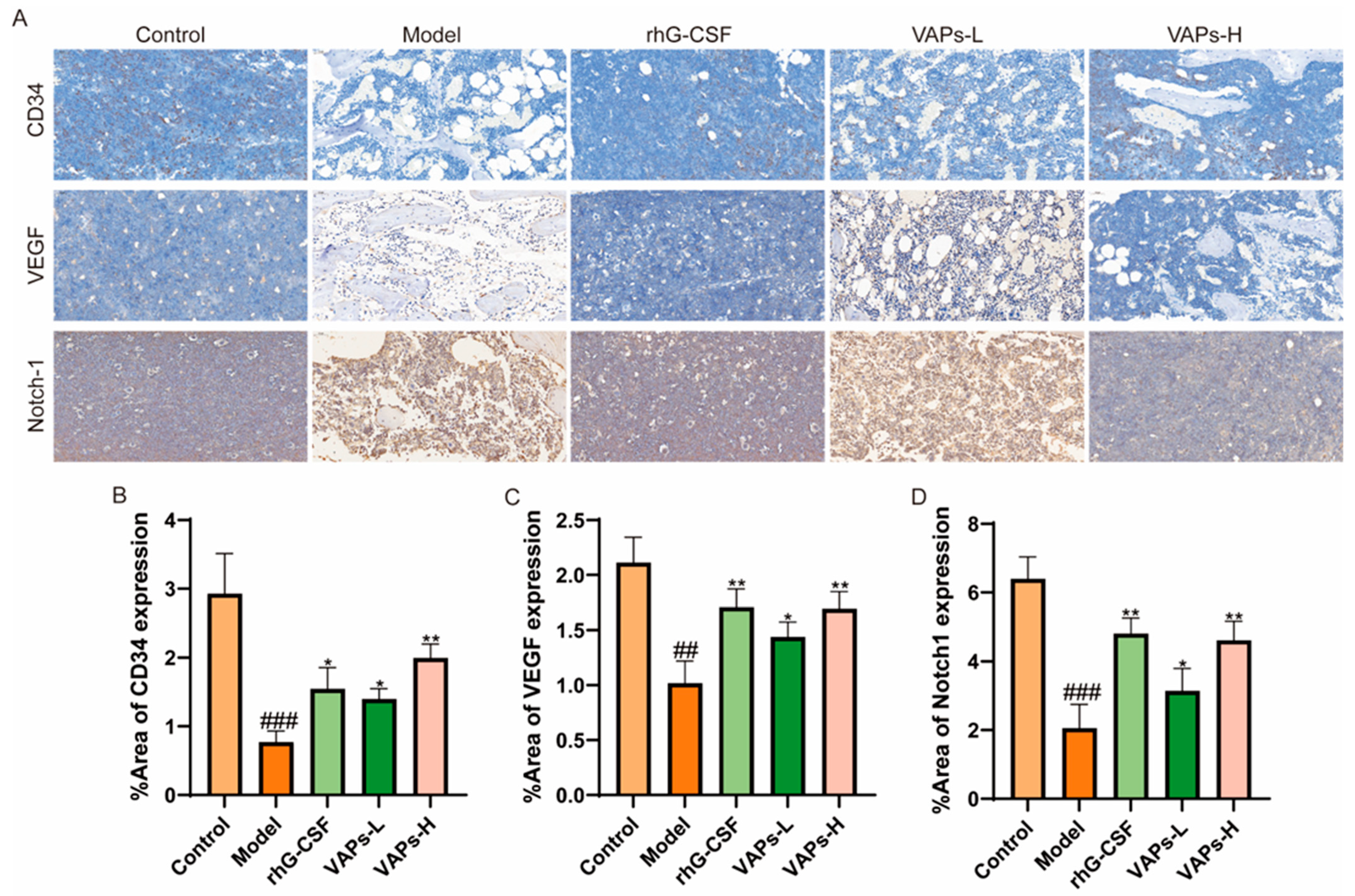

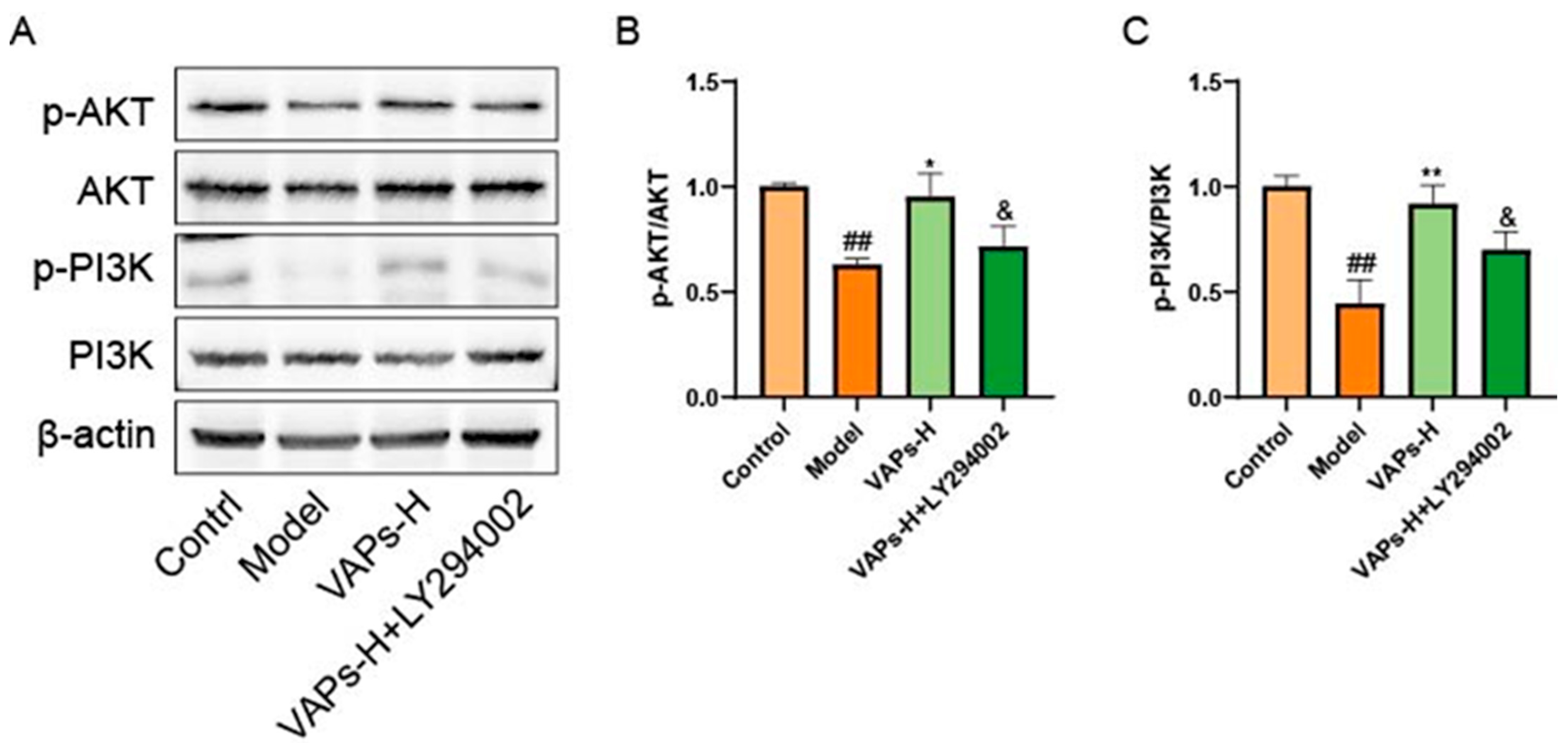
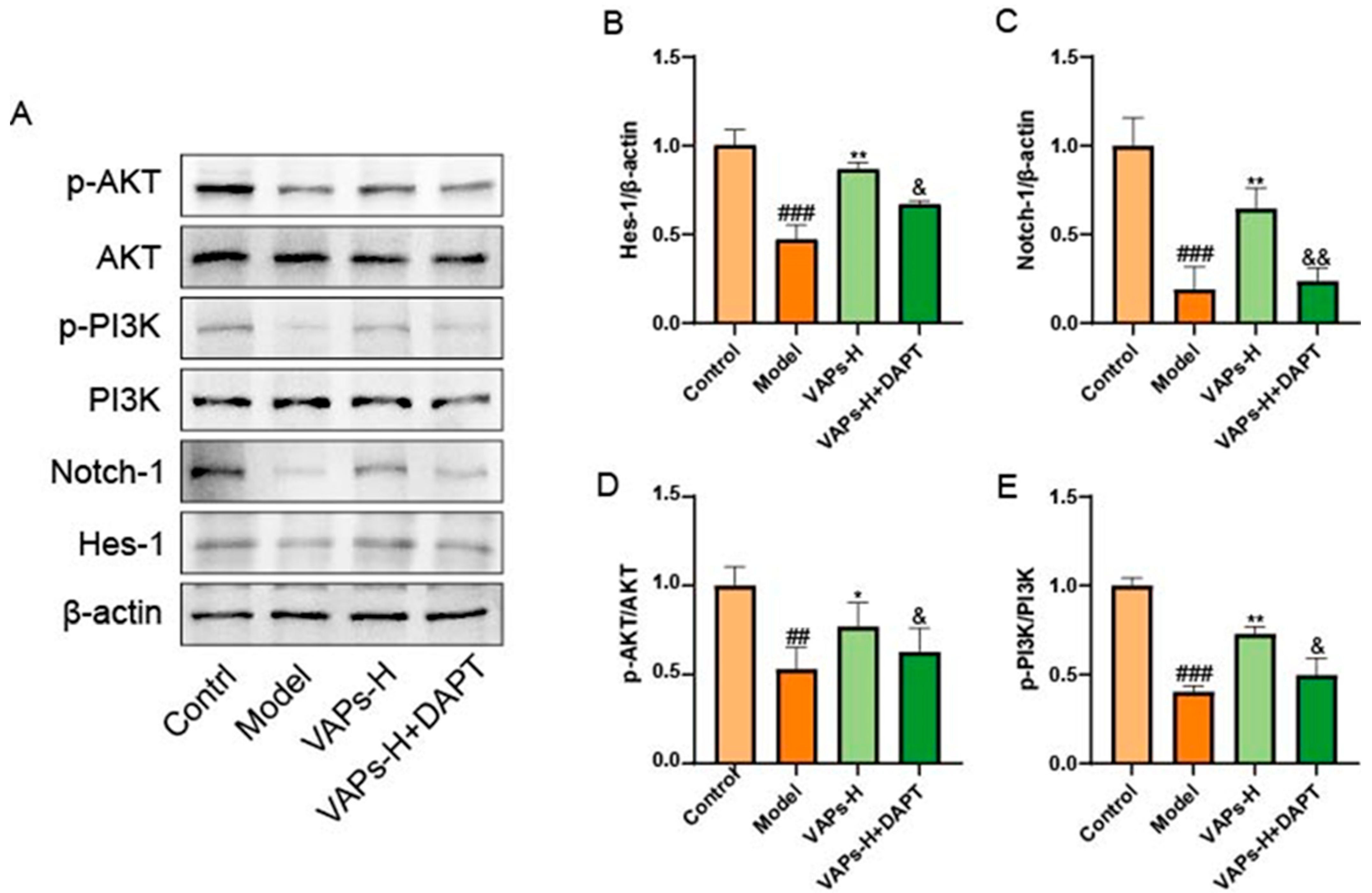

| Amino Acids | RT (min) | Conc (mg/g) |
|---|---|---|
| Asp | 8.387 | 57.187 ± 0.011 |
| Thr | 10.251 | 27.231 ± 0.050 |
| Ser | 11.140 | 32.090 ± 0.079 |
| Glu | 13.276 | 92.835 ± 0.007 |
| Pro | 14.672 | 52.799 ± 0.113 |
| Gly | 19.257 | 85.121 ± 0.091 |
| Ala | 20.38 | 49.977 ± 0.103 |
| Cys | 22.141 | 8.907 ± 0.023 |
| Val | 22.664 | 28.016 ± 0.150 |
| Met | 24.507 | 9.091 ± 0.068 |
| Ile | 25.828 | 16.793 ± 0.142 |
| Leu | 26.813 | 41.994 ± 0.019 |
| Tyr | 29.687 | 19.473 ± 0.073 |
| Phe | 30.507 | 26.993 ± 0.081 |
| His | 34.697 | 15.178 ± 0.138 |
| Lys | 37.337 | 40.975 ± 0.064 |
| Arg | 44.580 | 49.130 ± 0.0355 |
Disclaimer/Publisher’s Note: The statements, opinions and data contained in all publications are solely those of the individual author(s) and contributor(s) and not of MDPI and/or the editor(s). MDPI and/or the editor(s) disclaim responsibility for any injury to people or property resulting from any ideas, methods, instructions or products referred to in the content. |
© 2025 by the authors. Licensee MDPI, Basel, Switzerland. This article is an open access article distributed under the terms and conditions of the Creative Commons Attribution (CC BY) license (https://creativecommons.org/licenses/by/4.0/).
Share and Cite
Gao, F.; Wang, Y.; Liu, J.; Xie, Y.; Geng, Y.; He, Z.; Geng, J.; Li, J.; Chen, W.; Du, R. Protective Effects of Velvet Antler Polypeptides on Cyclophosphamide-Induced Myelosuppression in Mouse and Bone Marrow Mesenchymal Stem Cells. Nutrients 2025, 17, 3428. https://doi.org/10.3390/nu17213428
Gao F, Wang Y, Liu J, Xie Y, Geng Y, He Z, Geng J, Li J, Chen W, Du R. Protective Effects of Velvet Antler Polypeptides on Cyclophosphamide-Induced Myelosuppression in Mouse and Bone Marrow Mesenchymal Stem Cells. Nutrients. 2025; 17(21):3428. https://doi.org/10.3390/nu17213428
Chicago/Turabian StyleGao, Fusheng, Yusu Wang, Jinze Liu, Yichen Xie, Ying Geng, Zhongmei He, Jianan Geng, Jianming Li, Weijia Chen, and Rui Du. 2025. "Protective Effects of Velvet Antler Polypeptides on Cyclophosphamide-Induced Myelosuppression in Mouse and Bone Marrow Mesenchymal Stem Cells" Nutrients 17, no. 21: 3428. https://doi.org/10.3390/nu17213428
APA StyleGao, F., Wang, Y., Liu, J., Xie, Y., Geng, Y., He, Z., Geng, J., Li, J., Chen, W., & Du, R. (2025). Protective Effects of Velvet Antler Polypeptides on Cyclophosphamide-Induced Myelosuppression in Mouse and Bone Marrow Mesenchymal Stem Cells. Nutrients, 17(21), 3428. https://doi.org/10.3390/nu17213428





